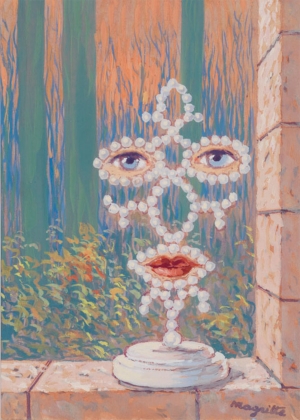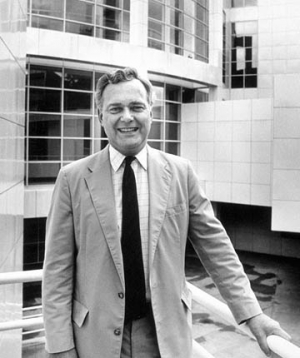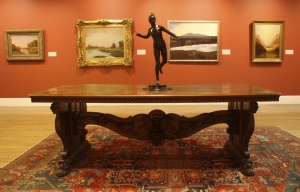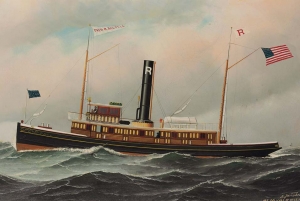|
Displaying items by tag: Decorative Arts

Now in its 58th year, the Brussels Antiques and Fine Art Fair (BRAFA) will take place January 19-27, 2013 at the exhibition space, Tour & Taxis. Featuring 128 dealers from 11 countries, the fair will present works from the Middle Ages to the 20th century including antiquities, jewelry, furniture, ceramics, drawings, engravings, Old Master as well as modern paintings, sculpture, textiles, contemporary art, photography, and much more.
After drawing in 46,000 visitors last year, BRAFA organizers have made a number of adjustments in hopes of surpassing 2012’s numbers. There will be 26 new exhibitors present and an increased emphasis has been placed on pre-Columbian art; archaeology; primitive arts; 17th to 19th century furniture; 19th to 20th century paintings, sculptures, and drawings; Asiatic arts; 20th century decorative arts; and modern and contemporary art. BRAFA has also added a new section to this year’s fair devoted to manuscripts. Exhibitors in this section include Signatures (Paris), Librairie Thomas-Scheler (Paris), and Sanderus Antiquariaat (Ghent, Belgium).
In honor of the fair’s tenth year at Tour & Taxis, BRAFA’s architects, Volume Architecture, have designed an extraordinary entrance inspired by Byzantine architecture, particularly that of the mosques in Istanbul.
VIP guests will be given a sneak peek of the impressive fair at BRAFA’s exclusive charity event on January 18. A silent auction will be held during the evening and proceeds will benefit the Merode Foundation to support its work on educational and social projects in Brussels’ working class neighborhoods.
Exhibitor highlights include Whitford Fine Art (London), which specializes in French and British 20th century painting and sculpture, Leysen Jewelers (Belgium), jewelers to the Belgian royal family, and Guy Pieters Gallery (Paris/Belgium), a leading force in the contemporary art world for the past 30 years.

Paris’ Musee du Louvre and the Fine Arts Museums of San Francisco, which includes the Legion of Honor and the de Young Museum, announced that they have reached a mutual agreement and will collaborate on a series of exhibitions and exchanges. The institutions will share works from their incendiary collections over the course of the next five years including antiquities, paintings, decorative arts, prints, drawings, textiles, and sculptures.
The Louvre and Fine Arts Museums have been working on the arrangement for the past two years and will celebrate its commencement with the exhibition, Royal Treasures from the Louvre: Louis XIV to Marie-Antoinette. The show, which opened on November 17 and features a collection of decorative arts from the French monarchy, will be on view through March 17, 2013.
The agreement will allow each world-renowned institution to broaden their international reach and inhabitants of each city will have a new selection of masterpieces to view. Loans between the museums may include entire exhibitions or single objects.

When Gudmund Vigtel was named the High Museum of Art’s director in 1963, it was a sensitive time for Atlanta’s art world. More than 100 members of the Atlanta Arts Association and their family members had died the year before in a tragic plane crash. The city’s civic leaders hoped that Vigtel could turn the museum into a living monument of sorts.
Vigtel came to the High Museum from the Corcoran Gallery of Art in Washington where he served as the assistant director. Civic leaders turned to Vigtel to spearhead the fund-raising campaign they started with hopes of remaking the museum. As it turns out, they chose the right man for the job.
During his 28 years at the High Museum, Vigtel transformed it from an unsuspecting, modest institution to one of the U.S.’s most renowned art museums. Vigtel oversaw the museum’s move from a small brick building to an architecturally groundbreaking 135,000-square-foot postmodern structure designed by Richard Meier. While the relocation happened in 1983, Vigtel began fund-raising and seeking out an architect in the mid-1970s.
Vigtel tripled the size of the High’s permanent collection and implemented an art appreciation program for children. He also started one of the country’s first African-American art collections. The decorative arts collection he opened at the museum has gone on to become one of the finest in the country. After acquiring hundreds of works by 19th- and 20th-century American and European artists, Vigtel left the High Museum with a $15 million endowment, which has since grown.
Vigtel died at his home in Atlanta at the age of 87. His wife, two daughters, four grandchildren, and a profound legacy survive him.

After twenty-two years, Nicholas Capasso will be leaving his post at the deCordova Sculpture Park and Museum in Lincoln, MA. Capasso, who is currently the deCordova’s deputy director for Curatorial Affairs, has been named the new director of the Fitchburg Art Museum and will start his latest venture on December 3.
During his time at the deCordova, Capasso has overseen a permanent collection that included 3,500 objects, changing gallery exhibitions, and an outdoor sculpture park. He helped to bring recognition to the institution and to reposition it as an important contemporary museum.
While Capasso specializes in contemporary art, he is eager to work with the Fitchburg Art Museum’s collection that spans more than 5,000 years and includes American and European paintings, prints, drawings, ceramics, decorative arts, and Greek, Roman, Asian, and pre-Columbian antiquities. The Museum’s collection, which is housed between twelve galleries, includes works by William Zorach, John Singleton Copley, Joseph Stella, Edward Hopper, Charles Burchfield, Charles Sheeler, Walker Evans, and Georgia O’Keeffe.
Capasso will take over the role of director from the soon-to-be-retired Peter Timms who has held the position since 1973.

On September 24th, Christie’s presented their American Furniture, Folk Art, and Decorative Arts Sale in New York. Spanning the 18th and 19th centuries, works included furniture from the Wunsch Americana Foundation, the Philadelphia Museum of Art, and American folk art and maritime paintings. The sale was 85% sold by lot and 93% by value.
The top lot was a Chippendale carved mahogany easy chair that was entrusted to Christie’s by the Philadelphia Museum of Art. Estimated at $600,000-$900,000 and attributed to the renowned yet mysterious Garvan carver, the chair brought in $1.16 million, the third highest price ever paid for the form. “We are thrilled to have been the successful bidders on the Garvan Carver easy chair. It is a wonderful chair,” said Todd Prickett of C.L. Prickett who specializes in American antiques. The Museum will use the funds for new acquisitions.
Another lot that brought in more than expected was a Queen Anne Japanned Maple Bureau Table. One of about forty known examples of japanned furniture from colonial America, it is the only bureau table known to exist. Estimated at $60,000-$90,000, the table sold for $98,500.
Two paintings by the maritime artist, Antonio Nicolo Gasparo Jacobsen (1850–1921), sold for more than their estimates that ranged from $12,000 to $18,000. The Paddlewheel Steamer St. John went for $45,000 while Fred B Dalzell went for $25,000.
Not all lots did as well as anticipated. A pair of Federal eagle-inlaid mahogany side chairs attributed to William Singleton were estimated at $60,000 to $90,000 but only sold for $32,500. The pair of chairs had been lent to the Diplomatic Reception Rooms at the Department of State in 1968 and remained in the Monroe Reception Room as part of a larger set of four related chairs until they were returned to the Wunsch Americana Foundation. Until know, the location of this particular pair was unknown.
When the Northwest Territory opened in 1788, settlers, lured by inexpensive, abundant land, flooded west into what would become Ohio. The federal government had divided up the land into a number of sections, with parts intended as payment to Revolutionary War veterans and to the states of Virginia, Massachusetts, New York, and Connecticut that had ceded the land to the U.S. government, while some was sold to speculators; an arrangement that led to an organized, yet complex, pattern of settlement. Many settlers arrived in groups, creating communities with close cultural ties to their eastern origins, and while some settlers fit the frontier stereotypes (backwoods hunters, Indian fighters, and pugnacious drunks), others were educated and affluent. These ambitious men took their families west to build the next phase of the American empire and in their wake came craftsmen and merchants.
|
|
|
|
|